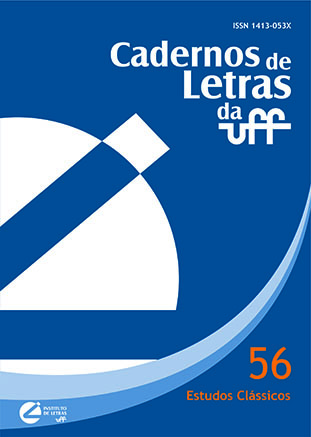‘A estrela cadente da comédia nova” (ap 2. 362): sobre o sucesso de Menandro no período imperial
DOI:
https://doi.org/10.22409/cadletrasuff.2018n56a531Palavras-chave:
Menandro, recepção, Período Imperial.Resumo
O presente artigo pretende examinar a recepção de Menandro no período imperial. Para isso, são trazidos exemplos pictográficos e literários que confirmam a popularidade do comediógrafo, argumentando-se que o sucesso e a posterior derrocada de Menandro estão intimamente ligados ao uso escolar que foi feito das comedias.
---
Downloads
Referências
BASSET, Sarah. The Late Antique Image of Menander. GRBS 48: 201-225, 2008.
BERCZELLY, Laszlo. ‘The Date and Significance of the Menander Mosaics at Mytilene”. BICS 35: 119-126, 1988.
BLANCHARD, Alain. ‘Destins de Ménandre”. Ktema 22: 213-225, 1997.
CRIBIORE, Rafaella. Gymnastics of the Mind: Greek Education in Hellenistic and Roman Egypt. Princeton: Princeton University Press, 2001.
DAIN, Alphonse. ‘La Survie de Ménandre”. Maia 15: 270-309, 1963.
EASTERLING, Pat. ‘Menander: Loss and Survival: ζώεις εἰς αἰω̑να (AP 9.187)”. BICS Supplement 66 : 153-160, 1995.
FANTHAM, Elaine. ‘The Roman Experience of Menander”. TAPhA 114: 299-309, 1984.
GILULA, Dowra. ‘Menander's comedies best with dessert and wine (Plut. Mor. 712e)”. Athenaeum 65: 511–16, 1987.
GUTZWILLER, Kathryn. & CELIK, Omar. ‘The New Menander Mosaics from Antioch‘. AJA 116 4: 573-623, 2012.
JOHNSON, William A. ‘Learning to Read and Write”. In: Bloomer, M. (ed.). A Companion to Ancient Education. Oxford: Wiley Blackwell, 2015, pp. 137-148.
JONES, C.P. ‘Greek Drama in the Roman Empire”. In: Scodel, R. (ed.) Theater and Society in the Classical World. Ann Arbor: University of Michigan Press, 1993, pp. 39-52.
KARAVAS, Orestes. & VIX, Jean-Luc. ‘On the Reception of Menander in the Imperial Period”. In: Somerstein, A. (ed.). Menander in Contexts. London: Routledge, 2014, pp. 183-198.
KASTER, Robert. ‘Notes on “Primary’ and “Secondary’ Schools in Late Antiquity”. TAPha 113: 323-346, 1983.
________. Guardians of the Language: The Grammarian and Society in Late Antiquity. Berkeley: University of California Press, 1988.
KONSTANTAKOS, Ioannis M. ‘"Rara coronato plausere theatra Menandro? Menander's Success in His Lifetime”. QUCC, vol. 88, n. 1, 2008, pp. 79-106.
LE GUEN, Brigitte. ‘The Diffusion of Comedy from the Age of Alexander to the Beginning of the Roman Empire”. In: Scafuro, A. & Fontaine, M. (ed.) Oxford Handbook of Greek and Roman Comedy. Oxford: Oxford University Press, 2014, pp. 359-377.
LIAPIS, Vayos. ‘How to Make a Monostichos: Strategies of Variation in the "Sententiae Menandri". HSPh, vol. 103, 2007, pp. 261-298.
LIGHTFOOT, Jane. ‘Nada a ver com os technîtai de Dioniso?”. In: Easterling, P. & Hall, E. Atores Gregos e Romanos: aspectos de uma antiga profissão. (trad. Raul Filker). São Paulo: Odysseus, 2008.
MORGAN, Teresa. Literate Education in Hellenistic and Roman Worlds. Cambridge: Cambridge University Press, 1998.
NERVEGNA, Sebastiana. Menander in Antiquity: the Contexts of Reception. Cambridge: Cambridge University Press, 2013a.
_________. ‘Greek Culture as Images: Menander’s Comedies and their Patrons in the Roman West and Greek East”. In: OLSON, Douglas. (ed.) Ancient Comedies and Receptions. Berlin: De Gruyter, 2013b, pp. 346-367.
PFEIFFER, Rudolf. History of Classical Scholarship: from the beginning to the end of the Hellenistic age. Oxford: Oxford University Press, 1968.
RUSSELL, Donald A. Greek Declamation. Cambridge: Cambridge University Press, 1983.
SILVA, Mária de Fátima. ‘A fortuna de um autor chamado Menando”. Rev. Port. de História do Livro 24: 31-60, 2009.
SLATER, Niall W. ‘The Evidence of the Zeugma Synaristosai Mosaic for Imperial Performance of Menander”. In: In: OLSON, Douglas. (ed.) Ancient Comedies and Receptions. Berlin: De Gruyter, 2013, pp. 366-376.
WEBB, Ruth. Demons and Dancers: Performance in Late Antiquity. Massachusetts: Harvard University Press, 2009.
WEBSTER, T.B.L. ‘Monuments Illustrating New Comedy”. Bulletin Supplement (University of London. Institute of Classical Studies), No. 11, 1961, pp. i, iii, v, vii, 1-47, 49-157, 159-239, 241-273. (= MINC)
Downloads
Publicado
Edição
Seção
Licença
Autores que publicam em Cadernos de Letras concordam com os seguintes termos:
Os autores mantêm os direitos e cedem à revista o direito à primeira publicação, simultaneamente submetido a uma licença Creative Commons CC-BY-NC 4.0, que permite o compartilhamento por terceiros com a devida menção ao autor e à primeira publicação pela Cadernos de Letras.
Os autores podem entrar em acordos contratuais adicionais e separados para a distribuição não exclusiva da versão publicada da obra (por exemplo, postá-la em um repositório institucional ou publicá-la em um livro), com o reconhecimento de sua publicação inicial na Cadernos de Letras.






